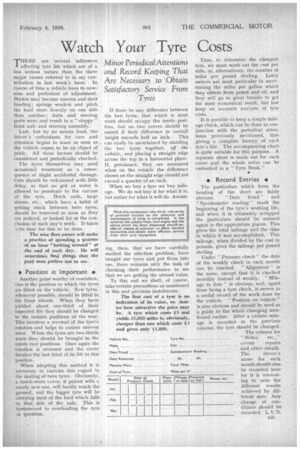Watch Your Tyre Costs
Page 23

If you've noticed an error in this article please click here to report it so we can fix it.
Minor Periodical Attentions and Record Keeping That Are Necessary to Obtain Satisfactory Service, From
Tyres
THERE are several influences I affecting tyre life which are of a less serious nature than the three• major causes referred to in my contribution in last week's issue. In course of time a vehicle loses its newness and perfection of adjustment. ' Brakes may become uneven and start binding ; springs weaken and pitch the load more heavily on one side than another ; hubs and steering parts wear and result in a " sloppy " front axle and steering assembly.'
Last, but by no means least, the driver's enthusiasm for care and attention begins to wane so soon as the vehicle ceases to be an object of pride. All these factors should be considered and periodically checked.
The tyres themselves may need occasional treatment as a consequence of slight accidental , damage. Cuts should be vulcanized with little delay, so that no grit or water is allowed to penetrate to the carcase of the tyre. Brick ends, large stones, etc., which have a habit of getting stuck between twin tyres, should be removed so soon as they are noticed, or looked for at the conclusion of each day's work. It takes :ittle time for this to be done.
The wise fleet owner will make a practice of spending a quarter of an hour "looking around" at the end of each day. He will sometimes find things that the paid man prefers not to see.
a Position is Important a Another point worthy of considera: tion is the position in which the tyres are fitted on the vehicle. New tyres, whenever possible, should be fitted to the front wheels. When they have yielded about one-third of their expected life they should be changed to the outside positions at the rear. This involves a reversal of the tyre's rotation and helps to correct uneven wear. When the tyres are two-thirds worn they should be brought to the inside rear positions. Once again the rotation is reversed and the cover finishes the last third of its life in this position.
When adopting this method it is necessary to exercise due regard to the mating of twin tyres. Obviously, a much-worn cover, if paired with a nearly new one, will hardly touch the ground, and the, bigger tyre will be carrying most of the load which falls to that Side of the axle. This is tantamount to overloading the tyre in question. If there be any difference between the two tyres, that which is most worn should occupy the inside position, but no two covers should be mated if their difference in overall height exceeds half an inch. This can easily be ascertained by standing the two tyres together, off the vehicle, and placing a straight edge across the top in a horizontal plane. If, peichance, they are measured when on the vehicle the difference shown on the straight edge should not exceed a quarter of an inch.
When we buy a tyre we buy mileage. We do not buy it for what it is, but rather for what it will do. Assum ng, then, that we have carefully studied the selection problem, have bought our tyres and put them into use, there remains only the task of Checking their performance to see that we are getting the utmost value.
To this end we shall, of course, take certain precautions as mentioned in this and previous instalments.
The first cost of a tyre is no indication of its value, no matter how attractive the price may be. A tyre which costs £5 and yields 25,000 miles is, obviously, cheaper than one which costs £3 and gives only 13,000.
Thus, to determine the cheapest tyre, we must work out the cost per mile, or, alternatively, the number of miles per pound sterling. Lorry owners are most particular in ascertaining the miles per gallon which they obtain from petrol and oil, and they will go to great trouble to get the most economical result, but few keep an accurate analysis of tyre costs.
It is possible to keep a simple mileage check, which can be done in conjunction with the periodical attentions previously mentioned, thus giving a complete history of each tyre's life. The accompanying chart is quite suitable for this purpose. A separate sheet is made out for each cover and the whole series can be embodied in a "Tyre Book."
• Record Entries •
The particulars which form the heading of the sheet are fairly obvious. "Date fitted" and "Speedometer reading" mark the beginning of the tyre's working life, and when it is ultimately scrapped the particulars should be • entered again in the appropriate places. This gives the total mileage and the time in which it was accomplished. This mileage, when divided by the cost in pounds, gives the mileage per pound sterling
Under " Pressure check" the date of the weekly check in each month can be inserted. " Alignment " is the same, except that it is checked monthly instead of weekly. "Mileage to date" is obvious, and, apart from being a tyre check, it serves as a useful record of the work done by the 'vehicle. "Position on vehicle" is also obvious and should be used as a guide to the wheel changing mentioned earlier. After a certain-mileage is recorded in the previous column, the tyre should be changed.
• The column for "Notes, 'etc.," covers repairs and other details.
The driver's name for each month should also be recorded here for it is interesting to note the different results achieved by different men. Any change of conditions should be recorded. L.V.B.


































